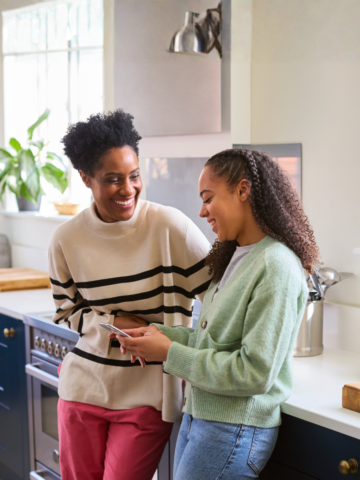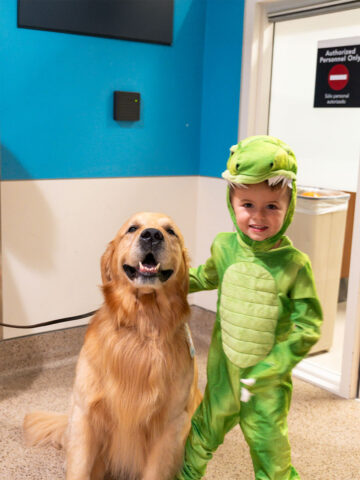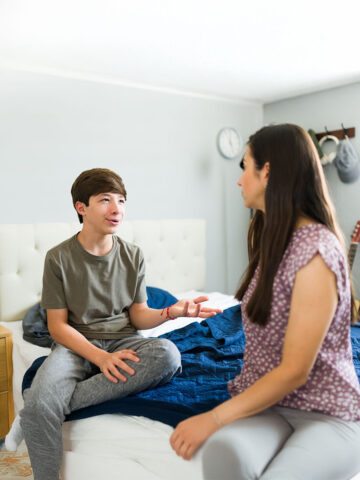By Dr. Heather Huszti, chief psychologist at CHOC, and
Dr. Sheila Modir, pediatric psychologist at CHOC
Taking care of your mental health, and your children’s mental health, is particularly important during a crisis such as the COVID-19 pandemic we’re currently living through.
There are many possible risk factors affecting children during this time that can lead to mental health distress:
- Shelter in place orders and disruption in former routines
- Loss of family from COVID-19
- Loss of family income
- Virtual schooling
- Lack of access to peers
- Possible violence in the home
These risk factors can compound existing mental health conditions or bring on new mental health challenges.
A study published by the Society for Disaster Medicine and Public Health polled families who faced isolation due to SARS or H1N1 and found that 30% of children met criteria for post-traumatic stress disorder (PTSD) per parent report. This rate was higher among children who received no mental health services and those whose parents had been isolated because of these diseases. If parents had anxiety or PTSD, their children were more likely to be impacted on a mental health level as well.
Research is emerging that suggests adults are struggling with increased mental health problems during the current COVID-19 pandemic. It also shows that many parents are worried about how to help their children’s mental health. These resources can help:
- 7 ways to help kids cope with coronavirus (COVID-19) anxiety
- Helping kids cope with COVID-19 stress
- How to talk to kids about disappointment during COVID-19
- How to help children who miss their friends during COVID-19
- Tips for parents of teens struggling with stay at home orders
- How to help your teen cope with COVID-19 cancellations
- CHOC pediatric psychologists demonstrate coping strategies in these videos
What happens when we are isolated
Research conducted by Australian psychologist and researcher Kimberley Norris found that when people are isolated due to a pandemic, they tend to cycle through different phases of emotion. How we feel and act can vary in these phases based on our age and other factors, but generally the cycle follows this pattern:
- Confusion – panic-buying, seeking clarity over regulations, or kids feeling unsure why they can’t see their friends at school anymore
- Honeymoon – finding a routine, adapting to work from home changes, feeling a sense of community
- Resentment – feeling cooped up or sick of wearing masks
- Reunion – the phase where we start to step out of isolation and may feel a rollercoaster of emotions. This could be, “I’m scared to get sick but I’m happy to go to the beach.”
- Reintegration – back to functioning normally in society
Through self-isolating and sheltering in place, we as clinicians worry that people in our community may not feel comfortable seeking the mental healthcare they need. However, telehealth is available and mental health sessions can be conducted from the safety of your home. Here’s advice on deciding where to go for physical healthcare during COVID-19.
The impact of trauma on children during COVID-19
The COVID-19 pandemic is a new mass trauma that can impact children’s mental health both now and later in life. This trauma will likely exacerbate existing mental health conditions and contribute to new stress-related illnesses.
If the signs and symptoms of trauma are left untreated, they can have a lasting impact on the child’s emotional, behavioral and physical well-being.
Signs and symptoms of trauma in children can include:
- Depression and/or anxiety
- Regression behaviors such as loss of toileting skills
- Increase in separation anxiety
- Changes in sleep, eating and school performance
- Engagement in risky behaviors
- Loss of interest in friends and/or activities
- Isolation
- Defiance
Tips for building resilience to mitigate the impact of trauma
There are a number of things parents can do to help children build resilience needed to thrive during this chaotic time, as well as help mitigate the impact of trauma. Resilient children tend to be happier, more motivated and engaged, more confident, and adopt a more positive attitude as they encounter more challenging situations. Here are some ideas to try in your own home:
Making a schedule
Whether times are uncertain or not, all children benefit from having a routine in place. Following a schedule provides consistency, structure and predictability. When we don’t know what the world is going to throw at us next, building in some routine and predictability serves as a buffer from the outside chaos.
Emotion identification
Today is a great day for a family movie night, and what movie does a better job of describing the internal world of a child than Pixar’s “Inside Out”? Consider making a family fort and gathering your favorite movie snacks. After the movie, grab some markers and paper and have your child draw what recent feelings they have experienced. What does that feeling look like? What would it say if it could talk? What does that feeling need to feel better or safe?
Coping skills
There are different ways to manage big emotions that children feel.
- Deep breathing – This will help the child calm and self-soothe. Breathe in for 3 seconds, hold it for 3 seconds, and release it for 3 seconds.
- Progressive muscle relaxation – Tense your muscles as you breathe in, and then relax them as you breathe out. This will help you identify in the future times of stress when you feel tense, and you can use deep breathing skills to help relax your body.
- Grounding – Bring your attention to the present moment using your five senses. For example, name five things you see in the room, four things you feel, three things you hear, etc.
Family coping box
A coping box can include tools that different family members can utilize when feeling stressed. The family box should be located somewhere that everyone can access it easily. Consider items such as a soft stuffed animal, word searches, a book of yoga poses, fidget toys or stress balls.
Conflict resolution
Stay at home orders can mean tight quarters, which can naturally lead to disagreements. Establish communication rules for your family, like using “I” statement to express how you feel, not interrupting each other, and taking a timeout when things get heated.
Mindfulness
Science has shown that the power of thought can change how we feel and lead to changes in those around us. One example of practicing mindfulness is a loving-kindness meditation. Since we can’t be with many of our loved ones right now, we can send them kindness and well wishes instead. Close your eyes, imagine the person or pet you care about and say aloud or silently, “May you be safe. May you be healthy and strong. May you be happy. May you be peaceful and at ease.”
Gratitude
Research has found that teaching gratitude to children increases their happiness, optimism and generosity. Encourage your children to keep a gratitude journal and to write three things every day they are grateful for. At the end of the week, everyone can share their reflections.
Get more expert health advice delivered to your inbox monthly by subscribing to the KidsHealth newsletter here.
Get mental health resources from CHOC pediatric experts
The mental health team at CHOC curated the following resources on mental health topics common to kids and teens, such as depression, anxiety, suicide prevention and more.





